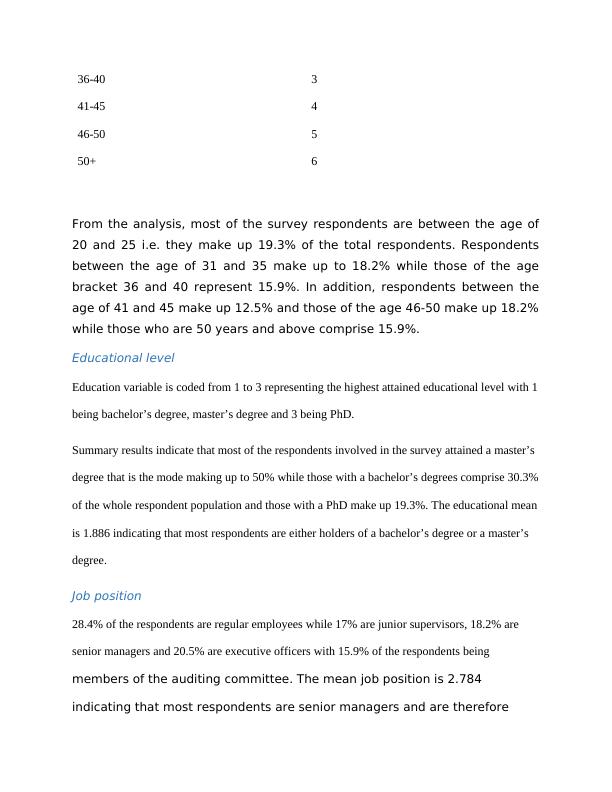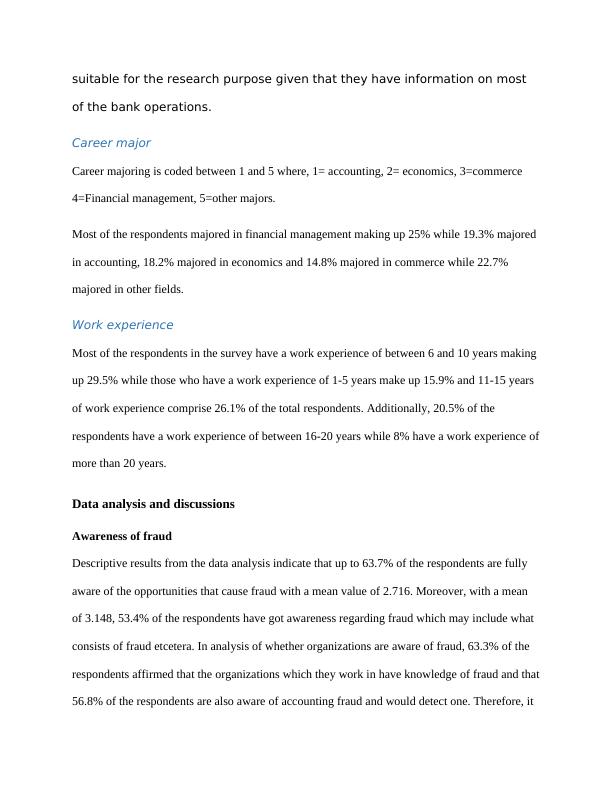Data Analysis, Results and Discussion
Added on 2023-05-30
14 Pages2066 Words198 Views
Data analysis, results and discussion
Descriptive statistics
The descriptive statistics give a general structure of the sample dataset used in analysis of the
role of an auditor in fraud detection. It mainly covers the distribution of the variables, that is
frequency, percentages, and averages such as: median, mean, and mode. There are 88
respondents who are involved in the survey working in 5 banks. The banks include:
i. Bank of Sharjah
ii. Sharjah Islamic bank
iii. national bank of Abu Dhabi
iv. bank of Dubai
v. Noor bank
Demographical statistics
Gender
Out of the 88 respondents, 47 are male which represent 53.4% while there are 41 female
respondents who make up 46.6%. We can therefore infer that there are more male and female
respondents.
Age
The age variable is coded from 1 to 6, where:
Age Code
20-30 1
31-35 2
Descriptive statistics
The descriptive statistics give a general structure of the sample dataset used in analysis of the
role of an auditor in fraud detection. It mainly covers the distribution of the variables, that is
frequency, percentages, and averages such as: median, mean, and mode. There are 88
respondents who are involved in the survey working in 5 banks. The banks include:
i. Bank of Sharjah
ii. Sharjah Islamic bank
iii. national bank of Abu Dhabi
iv. bank of Dubai
v. Noor bank
Demographical statistics
Gender
Out of the 88 respondents, 47 are male which represent 53.4% while there are 41 female
respondents who make up 46.6%. We can therefore infer that there are more male and female
respondents.
Age
The age variable is coded from 1 to 6, where:
Age Code
20-30 1
31-35 2

36-40 3
41-45 4
46-50 5
50+ 6
From the analysis, most of the survey respondents are between the age of
20 and 25 i.e. they make up 19.3% of the total respondents. Respondents
between the age of 31 and 35 make up to 18.2% while those of the age
bracket 36 and 40 represent 15.9%. In addition, respondents between the
age of 41 and 45 make up 12.5% and those of the age 46-50 make up 18.2%
while those who are 50 years and above comprise 15.9%.
Educational level
Education variable is coded from 1 to 3 representing the highest attained educational level with 1
being bachelor’s degree, master’s degree and 3 being PhD.
Summary results indicate that most of the respondents involved in the survey attained a master’s
degree that is the mode making up to 50% while those with a bachelor’s degrees comprise 30.3%
of the whole respondent population and those with a PhD make up 19.3%. The educational mean
is 1.886 indicating that most respondents are either holders of a bachelor’s degree or a master’s
degree.
Job position
28.4% of the respondents are regular employees while 17% are junior supervisors, 18.2% are
senior managers and 20.5% are executive officers with 15.9% of the respondents being
members of the auditing committee. The mean job position is 2.784
indicating that most respondents are senior managers and are therefore
41-45 4
46-50 5
50+ 6
From the analysis, most of the survey respondents are between the age of
20 and 25 i.e. they make up 19.3% of the total respondents. Respondents
between the age of 31 and 35 make up to 18.2% while those of the age
bracket 36 and 40 represent 15.9%. In addition, respondents between the
age of 41 and 45 make up 12.5% and those of the age 46-50 make up 18.2%
while those who are 50 years and above comprise 15.9%.
Educational level
Education variable is coded from 1 to 3 representing the highest attained educational level with 1
being bachelor’s degree, master’s degree and 3 being PhD.
Summary results indicate that most of the respondents involved in the survey attained a master’s
degree that is the mode making up to 50% while those with a bachelor’s degrees comprise 30.3%
of the whole respondent population and those with a PhD make up 19.3%. The educational mean
is 1.886 indicating that most respondents are either holders of a bachelor’s degree or a master’s
degree.
Job position
28.4% of the respondents are regular employees while 17% are junior supervisors, 18.2% are
senior managers and 20.5% are executive officers with 15.9% of the respondents being
members of the auditing committee. The mean job position is 2.784
indicating that most respondents are senior managers and are therefore

suitable for the research purpose given that they have information on most
of the bank operations.
Career major
Career majoring is coded between 1 and 5 where, 1= accounting, 2= economics, 3=commerce
4=Financial management, 5=other majors.
Most of the respondents majored in financial management making up 25% while 19.3% majored
in accounting, 18.2% majored in economics and 14.8% majored in commerce while 22.7%
majored in other fields.
Work experience
Most of the respondents in the survey have a work experience of between 6 and 10 years making
up 29.5% while those who have a work experience of 1-5 years make up 15.9% and 11-15 years
of work experience comprise 26.1% of the total respondents. Additionally, 20.5% of the
respondents have a work experience of between 16-20 years while 8% have a work experience of
more than 20 years.
Data analysis and discussions
Awareness of fraud
Descriptive results from the data analysis indicate that up to 63.7% of the respondents are fully
aware of the opportunities that cause fraud with a mean value of 2.716. Moreover, with a mean
of 3.148, 53.4% of the respondents have got awareness regarding fraud which may include what
consists of fraud etcetera. In analysis of whether organizations are aware of fraud, 63.3% of the
respondents affirmed that the organizations which they work in have knowledge of fraud and that
56.8% of the respondents are also aware of accounting fraud and would detect one. Therefore, it
of the bank operations.
Career major
Career majoring is coded between 1 and 5 where, 1= accounting, 2= economics, 3=commerce
4=Financial management, 5=other majors.
Most of the respondents majored in financial management making up 25% while 19.3% majored
in accounting, 18.2% majored in economics and 14.8% majored in commerce while 22.7%
majored in other fields.
Work experience
Most of the respondents in the survey have a work experience of between 6 and 10 years making
up 29.5% while those who have a work experience of 1-5 years make up 15.9% and 11-15 years
of work experience comprise 26.1% of the total respondents. Additionally, 20.5% of the
respondents have a work experience of between 16-20 years while 8% have a work experience of
more than 20 years.
Data analysis and discussions
Awareness of fraud
Descriptive results from the data analysis indicate that up to 63.7% of the respondents are fully
aware of the opportunities that cause fraud with a mean value of 2.716. Moreover, with a mean
of 3.148, 53.4% of the respondents have got awareness regarding fraud which may include what
consists of fraud etcetera. In analysis of whether organizations are aware of fraud, 63.3% of the
respondents affirmed that the organizations which they work in have knowledge of fraud and that
56.8% of the respondents are also aware of accounting fraud and would detect one. Therefore, it

can be inferred that most of the corporate workers are well aware of the issue of fraud i.e.
approximately more than 60%.
The impact of technology in detecting fraud
In the question of whether technology has made any progress in aiding the campaign against
fraud, 69.3% of the respondents have a general opinion that technology has been successful in
minimizing accounting fraud. The statistics are based on the assumption that respondents having
an opinion between 1 and 3 affirm to the role of technology while those of 4 and 5 do not affirm
that technology aids in minimizing fraud.
Possibility to detect and prevent fraud in UAE
21.5% of the respondents are neutral about the role of UAE in detection and prevention of crime
while 45.5% are affirmative that UAE has played an important role in detection and prevention
of fraud whereas 33% are not of the opinion that UAE is effective in the campaign against fraud.
Regression results for the variables influencing detection of fraud
Correlation analysis
From the correlation results (table1) we can conclude that there is no correlation between the
role of internal auditor, possibility of fraud detection, role of technology in fraud and awareness
of fraud given that the Pearson correlation coefficients are less than ±0.7 therefore existence of
one factor does not influence the importance of the other.
Internal auditors rolePossibilityTechnologyAwareness
Internal au 1
Possibility 0.036594 1
Technolog -0.17822 -0.04431 1
Awareness -0.18588 -0.02526 -0.2195 1
Table 1: Correlation analysis results
approximately more than 60%.
The impact of technology in detecting fraud
In the question of whether technology has made any progress in aiding the campaign against
fraud, 69.3% of the respondents have a general opinion that technology has been successful in
minimizing accounting fraud. The statistics are based on the assumption that respondents having
an opinion between 1 and 3 affirm to the role of technology while those of 4 and 5 do not affirm
that technology aids in minimizing fraud.
Possibility to detect and prevent fraud in UAE
21.5% of the respondents are neutral about the role of UAE in detection and prevention of crime
while 45.5% are affirmative that UAE has played an important role in detection and prevention
of fraud whereas 33% are not of the opinion that UAE is effective in the campaign against fraud.
Regression results for the variables influencing detection of fraud
Correlation analysis
From the correlation results (table1) we can conclude that there is no correlation between the
role of internal auditor, possibility of fraud detection, role of technology in fraud and awareness
of fraud given that the Pearson correlation coefficients are less than ±0.7 therefore existence of
one factor does not influence the importance of the other.
Internal auditors rolePossibilityTechnologyAwareness
Internal au 1
Possibility 0.036594 1
Technolog -0.17822 -0.04431 1
Awareness -0.18588 -0.02526 -0.2195 1
Table 1: Correlation analysis results

End of preview
Want to access all the pages? Upload your documents or become a member.
Related Documents
Effect of Transactional and Transformational Leadership Styles on Staff Performancelg...
|24
|3827
|27
Gender Empowerment in Advertisinglg...
|5
|1060
|166
